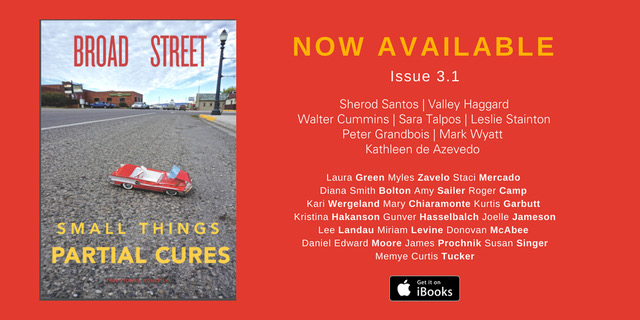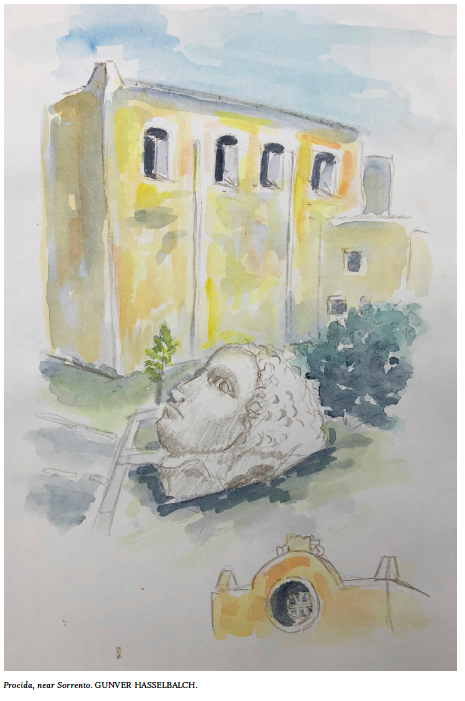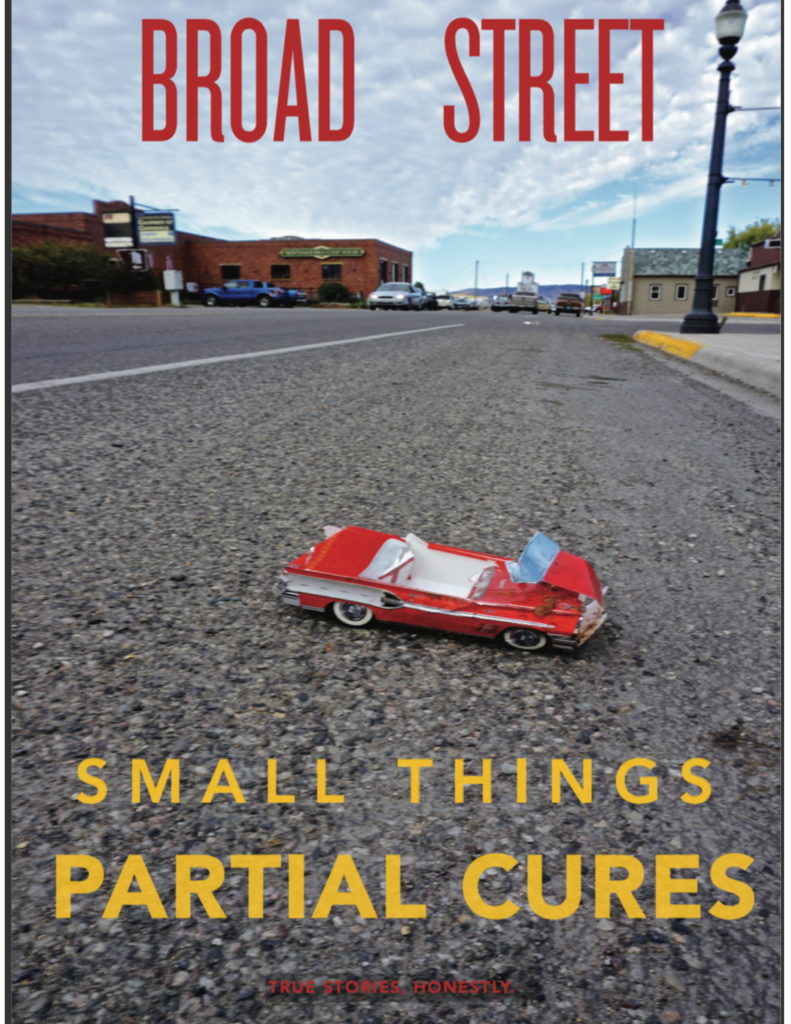Issue 3.1, “Small Things, Partial Cures,” hits hard …
Our latest issue (super-sized) features great new work by Sherod Santos, Leslie Stainton, Walter Cummins, Sara Talpos, Peter Grandbois, Valley Haggard, Staci Mercado, Mark Wyatt, Diana Smith Bolton, Kathleen de Azevedo, Gunver Hasselbalch, James Prochnik, and many more writers and visual artists who share their pain and offer at least a partial cure for what ails you too. Scroll down to see samples of their work and to read more about the personalities themselves.
We’re also excited to announce that with “Small Things, Partial Cures,” we usher in a new publishing model, one that will make Broad Street available wherever you are in the world, in either electronic or print form–still at a low, we’re-not-breaking-even-yet price.
Readers can download the entire issue on iBooks now; soon it will be available for print on demand. Our own print run will be smaller than before because of these new channels for publication. This way we’re keeping costs down and making sure Broad Street covers more territory than ever.
To buy your copy through iBooks, go here.
Or if you like things more complicated, take yourself to the iBooks store (you can search the web for “iBooks store” and get the link); when you’ve reached the store, search on “Small Things Partial Cures.” You’ll get right to us.
Once you’ve had time to peruse the issue, a review on iBooks would be greatly appreciated … Such reviews really do help good work find its readers!
And as always, some features will be available free of charge on our website, along with related Online Exclusives.
“The miniature makes us dream, Bachelard says. Enter its world, and immediately images begin ‘to abound, then grow, then escape.’” — Leslie Stainton
This sampler is available, in slightly different format, on Medium.
Cover image by Mark Wyatt.
**********************************************************************************
An Overture from the Editors
It might be the smallest things that move us most. They’re what hold our focus when the big things — call them God or History — overwhelm. We’re composed of tiny atoms, sure, and in ourselves we contain millions; within those millions, we’re prey to pain both physical and emotional, for which the cure is partial at best.
Our contributors find the devil in details. A doll adrift among a mother’s treasures inspires Leslie Stainton to recompose her mother’s past. A teenaged Diana Smith Bolton reinvents herself by piercing her ears, while Kathleen de Azevedo tracks a physical flaw that destroys the life of a mother from Brazil’s land of the body beautiful. Peter Grandbois’s life is a chronicle of injury and pain, and Staci Mercado tallies cancer’s toll on a body and a bank account. Kari Wergeland hopes science will help sperm meet egg; Walter Cummins’s wife’s mental disorder causes her family a legacy of hurt. Rachel Beanland digs for buried truth when she investigates one night in her grandfather’s life when he avoided the mob that lynched a prominent black businessman. Mark Wyatt photographs beggars in streets all over the world pleading for the smallest of offerings.
But there’s joy in small things too. We might find a cure, or at least a comfort, for suffering from the bubbles that wash our hair or our car, as in poems by Rachel Green and Joelle Jameson, or by counting the folds of flesh and even the scars that mark Valley Haggard’s decades of wholehearted living. Roger Camp’s photos of old toys can make us laugh out loud. When Sara Talpos puts a common bacteria under a microscope, she opens up a new understanding of Emily Dickinson. Sherod Santos commemorates the fleeting power of old gods, birds, and ruins.
Love and anger and sorrow evanesce; they are stuff of a mere moment. In the end, this is what remains: a fragment, a ruin, a head fallen from a Colossus. The smallest things become gods recovered from the wreckage of our past, carried into an uncertain future in the fragile scratches on the pages of a magazine.
Image: Near Sorrento, by Gunver Hasselbalch.
**********************************************************************************
We invite you now to sample some of the good things, large and small, in this rather more than usually large issue of the magazine.
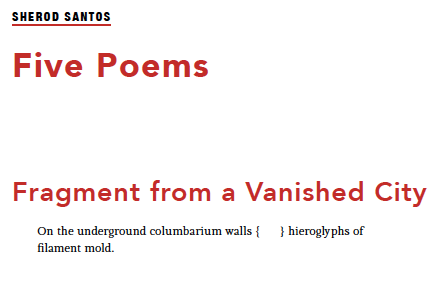
LESLIE STAINTON, “Miniature”: Try though I do, I cannot conjure this lost world. The plantation today is in ruins, decades after the rise of synthetic rope and the collapse of the sisal industry. My mother is gone. I did not pay enough attention while she lived (does anyone?), and the details are now irretrievable. […] Only in small moments would we connect. I remember a Christmas morning when she and I shared cups of sugared coffee in my bedroom before daybreak. We’d both woken early and couldn’t sleep. I was five. I cherish the scene as if it were my own small baby lying in a matchbox.
“Whereas physical perfection might be the road to temporary happiness, in Brazil, physical im-perfection is the road to Eternal Life.” — Kathleen de Azevedo
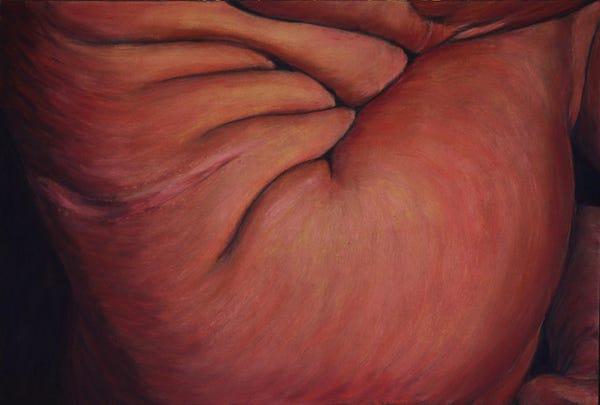
VALLEY HAGGARD, “The Body, in Parts”: Your body is not a thank-you note, my mother wrote to me in a card when I was in Alaska, half in love with the captain of the fleet, half in love with the deaf deckhand teaching me American Sign. Half dead, half drunk, half sober, half crazy…. Oh, but it was. It had been. It has also been my passport, my license, my excuse, and getaway car before it became a grave, a temple, a tombstone. My body has been a deadweight lump of unformed clay that I’ve kneaded and rolled and tried to shape, full of hidden treasure I’ve been desperate to find and spend. I’ve thrown it at strangers, hidden it from my husband, given it like a shield of flesh, an orchard of sustenance, a playground to my son.
Read the complete feature online for free here.
MIRIAM LEVINE:
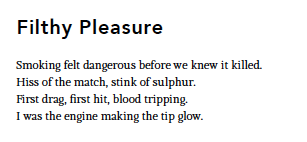
 The farther north one travels in Brazil, the harder life is, and the more visible the afflictions. There is not much in the way of “mobility devices” to hide the real difficulty of not being able to walk. The subway in Recife, for example, starts downtown, passes through a series of poor communities, and ends at the main bus depot. All along these stops, friends and family members bring disabled persons (some of whom are carried on the backs of the ablebodied) and place them in the cars in order to beg. The beggars drag their limp legs up and down the aisles, placing their hands on the knees of passengers and asking for money. These beggars force us to stare, and to consider the discrepancies in not only economic privilege but the privilege to move freely. They also create an ethical dilemma: If I look at their obvious disability, is this an insult? If I look away, am I being insensitive? If I give money, is that a futile drop in the bucket? When I say I have run out of change, do they believe me?
The farther north one travels in Brazil, the harder life is, and the more visible the afflictions. There is not much in the way of “mobility devices” to hide the real difficulty of not being able to walk. The subway in Recife, for example, starts downtown, passes through a series of poor communities, and ends at the main bus depot. All along these stops, friends and family members bring disabled persons (some of whom are carried on the backs of the ablebodied) and place them in the cars in order to beg. The beggars drag their limp legs up and down the aisles, placing their hands on the knees of passengers and asking for money. These beggars force us to stare, and to consider the discrepancies in not only economic privilege but the privilege to move freely. They also create an ethical dilemma: If I look at their obvious disability, is this an insult? If I look away, am I being insensitive? If I give money, is that a futile drop in the bucket? When I say I have run out of change, do they believe me?“The only real pain is your own.” — Peter Grandbois
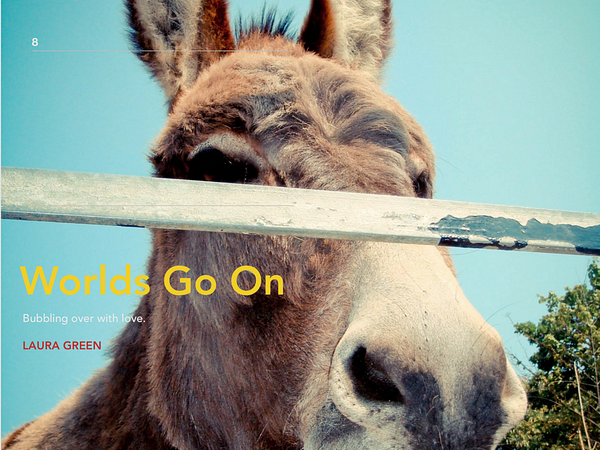
Donkey image by Kurtis Garbutt.
PETER GRANDBOIS, “Pain”: Your twenties are your prime fencing years. Each day you count the yellow bruises and red welts on your chest in the mirror. Sometimes you catch yourself pressing on them while in class or at work just to feel the sharp sting all the way through the bone, as if the pain carried more with it, and if you just kept poking at it, prodding it, you might find the answer to who you really are.
SARA TALPOS, “To Fill a Room with ‘Nobody’”:
 The bacteria, stained pink and magnified 2,000 times, looked like tiny pill capsules scattered across the slide. If I could line them up lengthwise — 18,000 of them — they would stretch as far as the first line in Emily Dickinson’s poem “Estranged from Beauty.” […] This movement of DNA across membranes reminds me of poetic enjambment: how a sentence or a thought is carried across a boundary — the poetic line — without punctuation to stop it.
The bacteria, stained pink and magnified 2,000 times, looked like tiny pill capsules scattered across the slide. If I could line them up lengthwise — 18,000 of them — they would stretch as far as the first line in Emily Dickinson’s poem “Estranged from Beauty.” […] This movement of DNA across membranes reminds me of poetic enjambment: how a sentence or a thought is carried across a boundary — the poetic line — without punctuation to stop it.AMY SAILER, “Litany of Missing Earrings”:

WALTER CUMMINS, “Commitment”: What would I find that afternoon when I drove home from that parking lot, eyes fogged, the road a blur, navigating from memory? Inevitably, a gaunt woman with fixed dark eyes and a tangle of wiry dark hair sitting rigid in a chair, engulfed by smoke, a cigarette squeezed between yellowed fingers. Her jaw would be clenched, but not tightly enough to stop the grinding or silence the endless mutterings of voices, the torment that had taken over her awareness of the actual. She wouldn’t react to my entry, the shutting of the front door, because she didn’t see, didn’t hear, didn’t care.
… Read the full text of Walter’s memoir here.
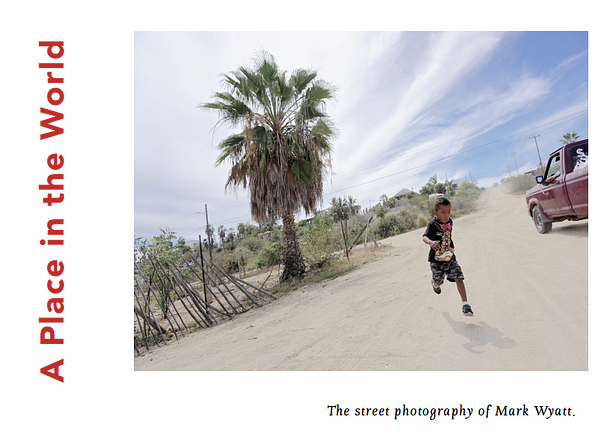
The scene that makes the perfect street photograph happens an incomprehensible number of times every moment. The mission of the photographer is to arrive just in time to save one of them.
STACI MERCADO, “The Cancer Business”: Chemotherapy $10,425/month. All we thought about were the three more years. What else to consider when facing the end? She began taking Doxorubicin, Asparaginase, Methotrexate, and Cytarabine with a Promethazine chaser for nausea. The nurses told me not to touch the first four with my bare hands. It’s poison, they said.
RACHEL BEANLAND, “The Murder of Allen Green”:
 All of Walhalla’s children grew up listening to stories about the night Allen Green was lynched, but they heard wildly different accounts. In the story my great-grandfather told, he narrowly avoided a run-in with an angry lynch mob. Other men told stories about the night they killed themselves a nigger. I can barely imagine the story that was relayed in Green’s family, and whether anyone who survived him could find the words to tell it at all.
All of Walhalla’s children grew up listening to stories about the night Allen Green was lynched, but they heard wildly different accounts. In the story my great-grandfather told, he narrowly avoided a run-in with an angry lynch mob. Other men told stories about the night they killed themselves a nigger. I can barely imagine the story that was relayed in Green’s family, and whether anyone who survived him could find the words to tell it at all.
MEMYE CURTIS TUCKER, Poems.
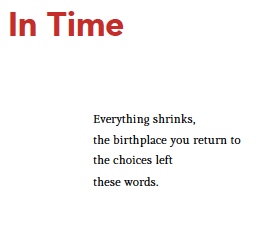
Thanks for spending some time with “Small Things, Partial Cures.” Remember the issue is available on iBooks here for the reduced price of $4.99.
Follow us here on Medium, our website, and Facebook for more teasers and extra features.
**********************************************************************************
In Brief, the Contributors
WORDS
Kathleen de Azevedo’s nonfiction, much of it about Brazil, has been published in The Los Angeles Times, Amèricas, North Dakota Quarterly, and Under the Sun. Her novel, Samba Dreamers, won the 2006 PEN Oakland Josephine Miles Award, given to work exploring diversity and human rights issues.
Rachel Beanland’s work has appeared in Creative Nonfiction, the blogs of Brain, Child Magazine and Mamalode, and in the Cup of Comfort and Catfish Stew anthologies.

Diana Smith Bolton is the author of the poetry chapbooks A Compass for My Bones and Just Universes, which won the 2016 Mid-Atlantic Chapbook Series. Her nonfiction, poetry, and fiction have appeared in over two dozen literary journals, such as Gargoyle, The Pinch, and anderbo.
Pigs in a Paris shop window, by Roger Camp.
Walter Cummins has published more than a hundred stories in such magazines as New Letters, Virginia Quarterly Review, Bellevue Literary Review, and Confrontation. Many of those stories have been collected in six books: Witness, Where We Live, Local Music, The End of the Circle, The Lost Ones, and Habitat: Stories of Bent Realism. His nonfiction books include The Literary Explorer, co-written with Thomas E. Kennedy; Programming Our Lives: Television and American Identity, co-written with George Gordon; and Florham: The Lives of an American Estate, co-written with Carol Bere and Samuel Convissor. With Thomas E. Kennedy, he is co-publisher of Serving House Books and curator of the Writers on the Job feature at WebdelSol.com, which has yielded two anthologies.

Laura Green’s micro-essays are part of a memoir, Bastard Child of a Renegade Nun, other bits of which have appeared or will do so soon on the Hip Mamma blog, in Tin House’s Flash Fidelity, and in an upcoming edition of Vinyl Poetry.
Valley Haggard is the author of The Halfway House for Writers and co-editor of Nine Lives: a Life in 10 Minutes Anthology, as well as numerous essays, stories, and reviews. She founded the online literary magazine Life in 10 Minutes and a year-round creative writing program, Richmond Young Writers.
Kristina Hakanson’s work has appeared in Tinderbox, Cactus Heart, Canary, and High Desert Journal. In 2016, she and her partner, Jonathan Brechner, completed The Ordinary Glow of Life, a collection of collaborative poems.
Joelle Jameson’s poetry has appeared in Salamander, Measure, The Knicknackery, and other journals. She reviews theater, galleries, and literary journals, and she is the Boston correspondent for ÆQAI, a journal of contemporary art criticism.
Lee Landau’s poetry has been published in Wisconsin Review, Reed Magazine, and Common Ground, and she is working on a poetry collection called Tangled Lives.
Miriam Levine is the author of The Dark Opens, winner of the Autumn House Poetry Prize; Devotion, a memoir; In Paterson, a novel; and three other poetry collections.
Donovan McAbee’s poems have appeared or are forthcoming in Tar River Poetry, RHINO, Jabberwock Review, Quiddity, The Christian Century, and elsewhere.
Staci Mercado won a Midwest Book Award for her historical novel, Seeking Signs, and she has published work in Barely South Review and Our Iowa. She was named the 2017 Outstanding Literary Arts Educator by the Midwest Writing Center.
Daniel Edward Moore is the author of a poetry collection, Confessions of a Pentecostal Buddhist, and of Pushcart-nominated poems published in journals such as The Spoon River Poetry Review, Rattle, Assaracus Review, and Columbia Journal of Arts and Literature.
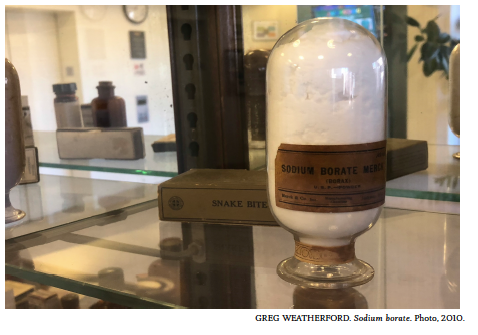
Amy Sailer’s poetry has appeared in journals such as Quarterly West, The Collapsar, and Meridian. She is the coordinator of the Poets in Print reading series in Kalamazoo, Michigan.
Sherod Santos is a poet, essayist, translator, and playwright whose ninth and most recent book, Square Inch Hours, was long-listed for the National Book Award. His poetry has been collected in six other books, including The Intricated Soul, The City of Women, and The Pilot Star Elegies, and his book of essays is A Poetry of Two Minds. He lives in Chicago, where he works in an outreach program for the homeless.
Leslie Stainton is the author of two books of nonfiction, Lorca: A Dream of Life and Staging Ground: An American Theater and Its Ghosts. Her essays have appeared in The American Scholar, The Sun, and Michigan Quarterly Review, among others.
Sara Talpos writes frequently about medicine, public health, and the environment. Her articles and essays have appeared in Kenyon Review, Undark, Mosaic, Medicine at Michigan, and numerous other publications. She is also a poet, with work in RHINO and Bellevue Literary Review.
Memye Curtis Tucker is the author of The Watchers, which won the Hollis Summers Poetry Prize from Ohio University Press. Her other publications include three chapbooks and many poems in Poetry Daily, the Georgia, Colorado, Oxford American, and Southern Reviews, Prairie Schooner, and Denver Quarterly.
Kari Wergeland’s poetry has been featured in Catamaran Literary Reader, Jabberwock Review: A Journal of Literature and Art, New Millennium Writings, Pembroke Magazine, and many other journals. Her chapbook, Breast Cancer: A Poem in Five Acts, is due out in June 2018.
Myles Zavelo is a new writer who interviewed Nicholas Delbanco for Literary Bennington.
IMAGES
Roger Camp is the author of three books of art photography, including the innovative Butterflies in Flight, which opens out to a twenty-three-foot spread of images. His work has appeared in over 150 magazines, including The New York Quarterly, New England Review, Redivider, Carolina Quarterly, and Witness.
Mary Chiaramonte’s narrative oil paintings have been featured in exhibitions throughout the U.S. She is the recipient of multiple honors for visual arts, including 2018’s Art Renewal Center publication award.
Gunver Hasselbalch has exhibited drawings and paintings in her native Denmark, where she also works in the theater.
Chad Hunt’s photographs have been featured in Time, Popular Mechanics, and The New York Times. His Afghanistan photographs received a Military Reporters and Editors Award and are in the permanent collection of the George Eastman House Museum. His photo essay on soldiers in the field and back at home appeared in Broad Street’s first issue, “Dangerous Territory,” and his series of Halloween portraits is an all-seasons popular feature on our website. His photo essay about Revolutionary War reenactors is scheduled for our next issue, “Rivals & Players.”
Avital Oehler is an Israeli-born, Los Angeles-based artist with a Master’s degree in forensic psychology. She works in photography, video, and other media as well as the written word. Her photos have been featured in shows across the U.S., and her short documentary, Notes on a Violin, won the award for best film in the Teacher category at the 2016 My Hero International Film Festival.
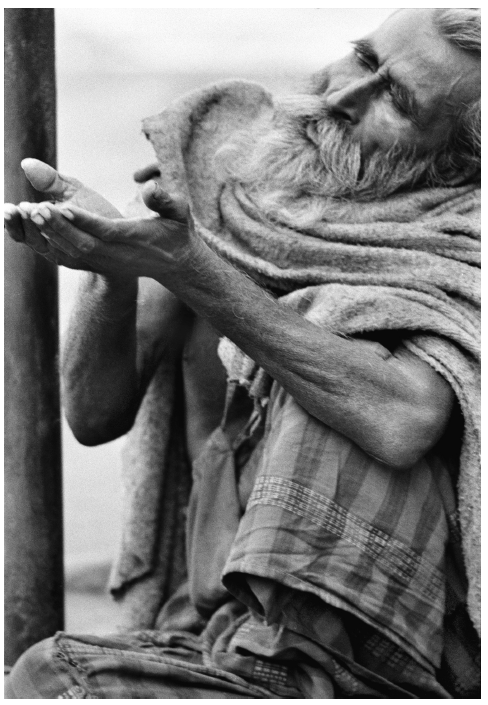
James Prochnik‘s photographic images have been represented by Photonica; published in Fortune Magazine, USAToday.com, Boston.com, Timeout.com, Gothamist, and Buzzfeed; and shown in galleries across the United States.
Susan Singer’s primary focus as an artist and writer is on beauty, whether it be of the body, the soul, the landscape, or the human condition. Valley’s Folds is from Beyond Barbie, a series of over fifty life-sized nudes of all sizes, shapes, ages, and races. Her work has been shown around the world, most recently in the Akureyri Art Museum in Akureyri, Iceland.
Mark Wyatt has been building a portfolio of street photographs since the 1980s. Some of his work has appeared in Broad Street’s “Maps and Legends” issue and in special features on our website.
Image: Beggar, Kolkata, India, 1980, by Mark Wyatt.
*************************************************************************************
We hope you’ll spend more time with “Small Things, Partial Cures”–please do come back for more.


